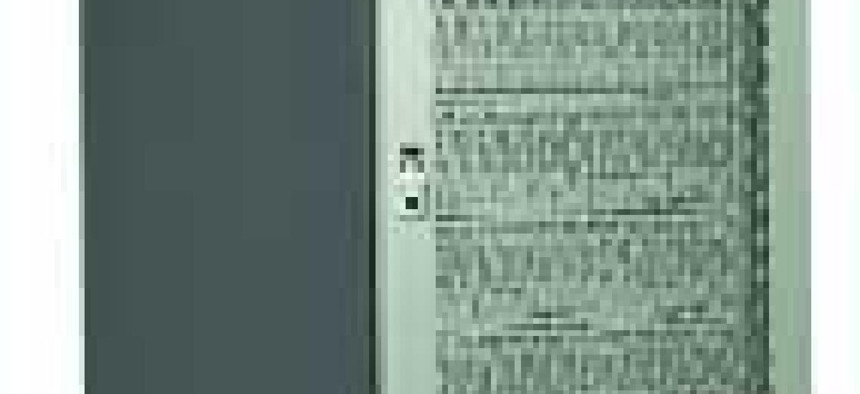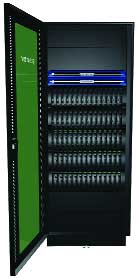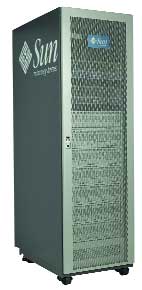The good news is that storage prices have fallen dramatically in recent years. The bad news is that this just encourages the purchase of more of it, compounding backup and restoration problems.'We have a couple of large servers that hold about 1.5 T of data,' said Andrew Ferguson, enterprise operations manager at Brookhaven National Laboratory. 'Doing a full backup on it would take days.'The laboratory has about 160 servers in its administrative data center, along with a storage-area network fabric. Two years ago, to address the dual issues of backup and restoration, Brookhaven installed an S2100-ES virtual tape library from Sepaton. The laboratory uses EMC's NetWorker to back up about 45T of data from the servers and the SAN. Most of it goes to tape, but the most critical data goes to the Sepaton VTL. Backing up a 1.5T server now takes less than 22 hours.'We can start it on Friday night, and it is done sometime Saturday, which is perfect,' Ferguson said. 'We recently restored that data to another server in a 24-hour window.'He added that restorations from the VTL are more reliable than restoring from tape.'When we first got it, everyone was a little nervous about keeping everything on disk with no physical tapes,' Ferguson said. 'We've had this for over two years now and have upgraded and expanded on it because we haven't lost anything.'Tape has never been an ideal backup technology, but it has had one overwhelming advantage: price.That was certainly the case in 2000 when, said Simon Robinson, senior analyst at the 451 Group, primary disk storage cost $80 per gigabyte, or 200 times the 40 cents per gigabyte cost for tape. By the end of 2005, the cost of tape storage fell to only 12 cents per gigabyte. Although that 70 percent drop in tape price is impressive, it does not compare to the way disk prices have decreased. By the end of 2005, primary disk storage cost $2.50 per gigabyte, and secondary drives were a mere 50 cents per gigabyte. Although disk storage remains somewhat more expensive than tape, the price is close enough that the advantages of disk storage ' speed, administrative costs and reliability ' may tip the scales for some users.Although disk storage systems have grown more popular, many organizations still have a significant investment in tape backup systems, including the backup software and procedures. This is where VTLs come into play. VTLs are disk arrays that appear to the backup software as tape drives.'The big value that VTL delivers is [that] it allows you to operate with precisely the same processes you have always operated with,' said Mike Karp, storage practice leader atEnterprise Management Associates. 'But in place of physical tape, you have a virtual tape.'This allows an organization to migrate part of its backup processes to disk while continuing to use tape for the rest.VTLs are generally set up in one of two configurations. One approach is to run it in parallel to the existing tape drives, so disk and tape backups are performed nearly simultaneously. The more common approach, though, is to run them in a disk-to-disk-to-tape configuration in which data is first backed up from the primary storage to the VTL and then later offloaded to tape for archiving.Switching from tape backup to a VTL offers organizations several advantages. The biggest of them is speed. Backing up data to disk is much faster than backing it up to a tape drive. This is especially critical as lengthening backup windows start intruding into peak operational periods.'The backup window was becoming increasingly larger, and many backups ran into the next business day because of sheer volume of the data,' said Sheetal Sood, New York City Department of Transportation systems manager.Setting up a 25T EMC Disk Library 710, a process that took less than a day, brought backup windows back under control.'Any other solution would have caused us to make many changes in the backup software configuration,' Sood said. 'But with the EMC Disk Library, we did not have to make any changes; the EMC solution appeared to the backup software just like any other tape library.'Chris Ferko, network operations manager for the city of Tucson, Ariz., reported similar results. When backup windows started extending into business hours, the city installed a 4T Hewlett-Packard 6518 Virtual Library System. 'By implementing the VTL, we were able to reduce our backup window to two hours from in excess of 10 hours.'But speed is not the only consideration in backing up data. Data is backed up so it can be restored, and disks are superior to tape in this area, too. Recovering data from tape is a cumbersome process of pulling and loading the right tape and then scanning for the required file.'It's not so great when you have to do a restore, and you find that the 5K file you are looking for is at the end of the 500-gig tape,' said Glenn Exline, manager of advanced technologies for Computer Sciences Raytheon at Patrick Air Force Base, Fla. Since the base installed a VTL from Network Appliance, that is no longer a problem. Recovery from disk is a simple matter of locating and restoring the file to a hard drive, a process measured in minutes.'There's no hunting for the tapes, there's no spooling the tape in, there's no indexing and finding the data on the tape,' he said. 'Typically, once we start a restore, the data is actually spooling off in less than five seconds.'This, of course, makes a big difference in service levels.'More rapid and reliable recoveries boosts customer satisfaction,' Karp said. 'You can really make IT shine, because now people aren't waiting for hours or days to get a recovery.'Plus, with tape there is always the question of whether the data can be reliably backed up and restored at any speed.Nightly backup failures are a common occurrence, and there is the question of whether data will be recovered properly from tape. This is especially critical when rebuilding a crashed server, such as the 1.5T of data Ferguson recently restored.'When you have that much on a server, you always fear that one bad tape is going to blow you out of the water,' he said. 'With the VTL, you know you can just start the restore and go home. You don't have to worry about it.'There are two basic approaches to implementing a VTL. One can purchase the disk array and VTL software separately or buy them as an integrated system.'The advantage to a preconfigured system is that IT doesn't have to get into the system configuration business,' Karp said. 'On the other hand, there might be a price penalty for that.'Each of the customers interviewed for this article had selected a preconfigured system, and installation took less than a day.Most of the major storage vendors have a VTL offering, and there are VTL specialists such as Sepaton and FalconStor. In evaluating competing products, Robinson recommends that agencies look at four key areas:'Users should be fully aware of whether the VTL or the backup application controls the movement of data from the VTL to the physical tape library,' Karp said. 'VTLs differ in their implementation here.'Other areas to look at are deduplication and encryption. These are becoming increasingly popular, but Karp cautions that both should be done in hardware, rather than software.'There are only so many CPU cycles to go around,' he said. 'If done in software, they produce a huge performance hit.'Given the advantages VTLs offer, coupled with the rapid price drops for disk storage, IDC forecasts that the VTL market will double to $1.4 billion by 2011, with VTL capacity showing a sevenfold growth during that same time period.But the long-term prospects for VTL are uncertain.'Although we don't think VTLs will disappear anytime soon (i.e., in the next two to three years), in the longer term they will become less important as the nature of backup changes,' Robinson said. 'VTLs are only popular because backup applications don't know how to talk better to disks.'As vendors improve their software, it will no longer be necessary to emulate tapes. Straight disk-to-disk backup systems can be implemented. But in the meantime, VTLs offer a simple solution to meeting current backup and recovery needs.'If you are an agency that has a tape library and need faster backups or want to institute primary backups while not having your IT personnel make numerous backup software configuration changes, a virtual tape library is definitely the way to go,' Sood said. 'As a bonus, you get less to [no] hardware failures and you don't need staff to swap out tapes.'
Times Eight: The Sepaton S2100-ES2 holds up to eight nodes and scales to more than a petabyte.
Fast Transfer: Sun's VTL Plus features 700 plus megabits/sec throughput.
- Whether it is fully compatible with existing systems.
- How much data needs to be stored online.
- Whether it is software or appliance.
- Who you call ' the backup or the VTL vendor ' when a problem occurs.
On the growVirtual Tape Libraries
| Vendor | Representative Product(s) | Notes |
Copan Systems
Longmont, Colo.
(877) 267-2699
www.copan.com | Revolution 221T and 220TX | 28 to 448 T/rack and up to 8 FC connections. Uses Massive Array of Idle Disks architecture, where disks are only spinning when data is being written to or retrieved from them. This saves electricity when used with rarely accessed data. |
Diligent
Technologies
Framingham, Mass.
(508) 663-1300
www.diligent.com | VTF Open, VTF Mainframe
| VTL software for mainframe and open systems. Works with disk arrays from 3PAR, EMC,HP, LSI Logic, HDS and others. |
EMC
Hopkinton, Mass.
(703) 970-5818
www.emc.com | CLARiiON Disk Library | The Disk Library 4000 series uses 4 gigabits/sec technology, with EMC's UltraScale architecture.
|
FalconStor
Software
Melville, N.Y.
(631) 777-5188
www.falconstor.com | VirtualTape Library | Two versions of the appliance work with FC or iSCSI connections. The appliance does not contain the disk array but works with other vendors' arrays. |
Hewlett-Packard
Palo Alto, Calif.
(800) 727-5472
www.hp.com | Storageworks Virtual Library System | The VLS 1000i is a small appliance for branch office or workgroup backups. The 6000 scales up to 70T and 550 megabits/sec throughput. |
IBM
Armonk, N.Y.
(888) 839-9289
www.ibm.com | TS7510 Virtualization Engine | Single- or dual-frame system with as much as 46T native capacity. 8 FC Ports. |
Network Appliance
Sunnyvale, Calif.
(800) 443-4537
www.netapp.com | NearStore Virtual Tape Library
| Three models with as much as 128T raw capacity, 512 virtual libraries and 20,000 virtual tapes. 1,200 megabits/sec maximum sustained write throughput. Up to eight 4 Gb FC ports. |
Overland
Storage
San Diego
(434) 244-7457
www.overlandstorage.com | REO 1000/4000/9000 | Storage appliances holding from 2T to 44T. Drives can be assigned as virtual tape libraries, virtual tape drives or disk volumes.
|
Quantum
San Jose, Calif.
(410) 867-4193
www.quantum.com
| DX, DXi and Pathfinder arrays
| DX, DXi and Pathfinder disk arrays can be used as VTLs. The DXi series includes deduplication. Capacities range from 4T to 920T with backup speeds as fast as 800 gigabits/hour. Arrays can be used for replication or disk backup in addition to as a VTL. |
Sepaton
Marlborough, Mass.
(508) 490-7900
www.sepaton.com | S2100-ES2 | Each appliance contains as many as eight nodes, each with dual FC connections. Appliance capacity scales from 4.8T to more than 1 petabyte. Software options include deduplication and remote replication. |
Sun Microsystems
Santa Clara, Calif.
(800) 232-4671
www.sun.com | Sun StorageTek VTL Plusuct | As many as 224T raw storage per rack. 700 plus megabits/sec throughput. Available with one or two Sun Fire v40z servers, each with two dual-core AMD Opteron CPUs. |








